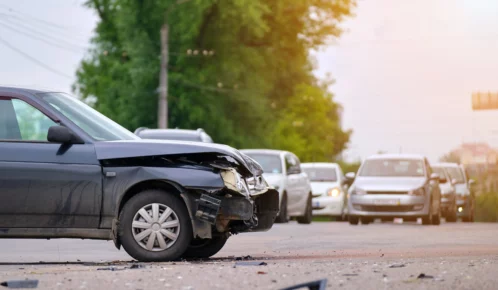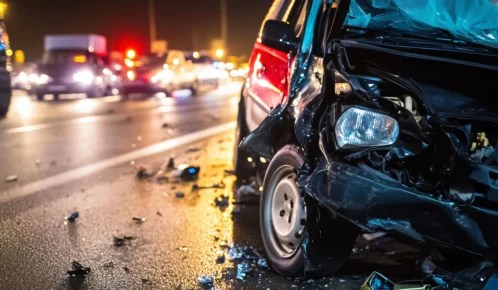Drivers or government agencies responsible for installing and servicing traffic signals might be liable for accidents when traffic signals are not working. Malfunctioning traffic lights pose a significant safety hazard to both motorists and pedestrians. On top of causing grievous injuries to motorists and pedestrians, these accidents also lead to significant property damage.
Table of Contents

How Malfunctioning Lights Cause Accidents
Traffic signals tell road users when to proceed and when to yield the right of way. At times, these essential systems cease to function as expected, however. The faulty traffic signs often result in minor or life-changing injuries, including death.
Conflicting Signals
Like other machines, these automated signals are prone to malfunctions over time. Lights can begin to change or flicker erratically. A driver may think he or she has ample time to make it through an intersection with a green light. In reality, however, the lights change to red before the driver has made it through the busy intersection. This confusion results in deadly T-bone accidents, head-on collisions, or even pedestrian accidents.
Obscured Lights
At times, the lights may work perfectly, but are obstructed or covered by overgrown tree branches or dirt. As such, these signals are not visible to road users. Obstructed traffic lights pose a significant collision risk, especially to new drivers like tourists or out-of-town motorists traveling in unfamiliar territories.
Sometimes, the traffic lights can get knocked down or displaced by other motorists. Severe weather, like strong winds, can also down the signs. Either way, these covered lights impair road users from making the right decisions.
Road signs may fail because of poorly programmed timers, wear and tear, illegal tampering, and vandalism. They may also malfunction because of the effects of past accidents and recurrent power outages.
Who Is to Blame for an Accident Involving Faulty Traffic Signals?
Two parties are often liable for an accident caused by faulty traffic signals. Municipal authorities may be held legally responsible for the crash. After all, they are responsible for installing and maintaining these road safety devices. A careless or inattentive driver can also be liable for some accidents involving defective traffic signals.
How Another Driver May Be Liable for Automobile Accidents Involving Defective Lights
In Illinois, a driver must comply with the right-of-way requirements, as outlined in the Illinois Vehicle Code, even when approaching or entering an intersection when traffic signals are not working. That means vehicles should always come to a complete stop, yield the right of way, and stop until there is no traffic at the intersection before proceeding. Otherwise, the motorist may be liable for the accident caused by failure to yield to the driver who has the right of way.
The law, therefore, requires motorists to exercise extreme caution and care, regardless of whether lights are working. A faulty signal should not be an excuse to drive carelessly, especially at busy intersections. Drivers should stop and assess the traffic movements instead of relying on the safety lights alone.
You can recover damages stemming from an accident when traffic signals are not working if you can prove the other driver disregarded the safe driving laws. Footage of surveillance cameras near the scene and witness statements may help you demonstrate that the other driver bears significant blame in such a situation.
Can the Government Be Liable for a Car Accident When Traffic Signals Are Not Working?
In Illinois, government agencies are not automatically responsible for damages caused by defective road safety signs. The fault primarily rests on the drivers. But, the government can be held liable for accidents when traffic signals are not working or obstructed. After all, the duty of installing and maintaining proper signals rests squarely on these government entities. You have to provide evidence that the authorities abandoned their care responsibilities, leading to your economic and non-economic losses.
Numerous parties may sometimes be liable for the defective signals. For example, the municipal may have subcontracted the installation and maintenance of the signs to third parties. As such, the government agencies refute the liability. In such situations, the courts use comparative negligence laws to determine the recoverable sums from these responsible parties.
What Is the Statute of Limitations for Car Accidents Caused by Faulty Traffic Lights?
Whereas most car accident victims have a window of up to 2 years to file claims, cases involving government agencies often get processed within 3 to 6 months after the accident. To receive compensation, one needs to prove that the municipality breached the owed duty of care in installing and maintaining working lights, and that the breach led to injuries and damages.
Determining Liability in a Car Accident Caused by Defective Traffic Signals
Determining liability in crashes involving defective traffic signals is tricky. The signal mix-up could have resulted in a chaotic scene, making identifying the liable party hard. Generally, however, the liability for accidents when traffic signals are not working is apportioned to another driver or the municipal authorities.
Certain threshold limits have to be met to successfully sue the other drivers or the government for the resulting damages and injuries. You need to prove that the municipal agencies were indeed responsible for installing and servicing the faulty signals. You need to show that the authorities failed to perform necessary repairs despite knowing that the traffic lights were not working. You must also prove that there were no other signals or warnings to caution motorists or pedestrians about the defective signage.
Knowing how to prove you are not at fault in a car accident involving inoperative traffic signals can help you avoid liability and maximize your compensation. Proving you are not liable in such accidents is not an easy task, however.
For starters, the victim’s assertions that the accident was not his or her fault often get met with skepticism and doubt. The traffic officers who respond to the crash often find it hard to believe that the accident arose from a defective or malfunctioning signal.
Secondly, insurers are usually quite hesitant to accept liability in accidents involving faulty traffic lights. Many injured parties, especially those who pursue the case alone, often get locked out of compensation by insurance companies. That is why it is imperative to hire a qualified attorney to build a solid claim that will get you a desirable outcome.
What to Do After a Car Accident Caused by Defective Traffic Signals
Knowing what to do after a car accident involving defective traffic signs can also improve your chances of receiving adequate compensation for your injuries and losses.
When involved in such a road collision, stay calm as you assess the aftermath. You should find out if you have sustained any injuries. Also, check to see if the passengers and the other drivers are okay. Call 911 to request an ambulance to the nearest hospital when faced with severe injuries.
Never admit that you are in the wrong or at fault for the crash. Avoid uttering self-incriminating statements to the responding officers or the other involved parties. Such admission may be used to hold you liable for the crash. They may also help insurance companies deny or undervalue your claim.
What to Do When Traffic Lights Are not Working Properly
Properly functioning lights ensure safe traffic movements. There are laws in place dictating when to yield the right of way or when to stop. When a traffic signal light is not working you should pay attention to what it’s doing to ensure you and others are safe on the road. Here is what to do when traffic signals are not working to minimize the risk of getting into an accident:
Flashing Red Signs
What should you do if a traffic signal is malfunctioning? Typically, a malfunctioning signal displays a flickering red light. Upon noticing such an anomaly, you should treat the signal as a stop sign. You should come to a complete stop and manually inspect when it is safe to proceed.
Flashing Yellow Signs
Defective or malfunctioning lights can also display a flickering yellow light. Ideally, yellow lights indicate that the driver has permission to proceed. But, if the yellow sign does not change, it may be faulty. When traffic signals are not working, you should first yield to oncoming traffic before proceeding.
Blacked Out Signals
The traffic laws state that drivers should come to a grinding halt at blacked-out lights. In such instances, the driver who got to the intersection first has the right of way over the other motorists. Despite arriving first, that driver still needs to confirm that it is safe to proceed. If two drivers arrive at the intersection at roughly the same time, the vehicle on the right side of the road has the first precedence to proceed.
Why You Need Legal Representation
Establishing liability for accidents when traffic signals are not working is not always an easy task. You must investigate the crash and review compiled evidence to identify the at-fault party. Working with experts like road designers, engineers, and reconstructionists might also be necessary. As such, it is better to leave the work of proving liability and pursuing the damages to a lawyer who has dedicated his or her practice to handling car accident cases.
Your car accident lawyer will help you build a robust case, leaving the at-fault party or at-fault party’s insurer with no other option except offering a decent settlement. An experienced lawyer at Ankin Law can ensure you have complied with strict deadlines and confusing procedures of pursuing compensation from government agencies. Contact Ankin Law for professional representation in your car accident case.



